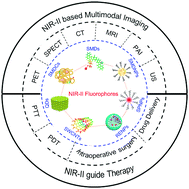当前位置:
X-MOL 学术
›
Chem. Soc. Rev.
›
论文详情
Our official English website, www.x-mol.net, welcomes your
feedback! (Note: you will need to create a separate account there.)
Crucial breakthrough of second near-infrared biological window fluorophores: design and synthesis toward multimodal imaging and theranostics
Chemical Society Reviews ( IF 40.4 ) Pub Date : 2018-05-04 00:00:00 , DOI: 10.1039/c8cs00234g Shuqing He 1, 2, 3, 4, 5 , Jun Song 1, 2, 3, 4, 5 , Junle Qu 1, 2, 3, 4, 5 , Zhen Cheng 6, 7, 8, 9, 10
Chemical Society Reviews ( IF 40.4 ) Pub Date : 2018-05-04 00:00:00 , DOI: 10.1039/c8cs00234g Shuqing He 1, 2, 3, 4, 5 , Jun Song 1, 2, 3, 4, 5 , Junle Qu 1, 2, 3, 4, 5 , Zhen Cheng 6, 7, 8, 9, 10
Affiliation

|
The development of fluorophores and molecular probes for the second near-infrared biological window (NIR-II, 1000–1700 nm) represents an important, newly emerging and dynamic field in molecular imaging, chemical biology and materials chemistry. Because of reduced scattering, minimal absorption and negligible autofluorescence, NIR-II imaging provides high resolution, a high signal-to-noise ratio, and deep tissue penetration capability. Among various state-of-the-art bioimaging modalities, one of the greatest challenges in developing novel probes is to achieve both high resolution and sensitivity. The chemical design and synthesis of NIR-II fluorophores suitable for multimodal imaging is thus emerging as a new and powerful strategy for obtaining high-definition images. NIR-II fluorophores may convert NIR-II photons into heat for photothermal therapy and be excited by NIR-II light to produce singlet oxygen for photodynamic therapy. The presence of simultaneous diagnostic and therapeutic capabilities in a single probe can be used for precise treatment. In this review, we have focused on recent advances in the chemical design and synthesis of NIR-II fluorophores from small organic molecules to organic and inorganic nanoparticles, and we have further discussed recent advances and key operational differences in reported NIR-II imaging systems and biomedical applications based on NIR-II imaging, such as multimodal imaging, photothermal and photodynamic therapy, guidance for intraoperative surgery, and drug delivery.
中文翻译:

第二个近红外生物窗口荧光团的关键突破:面向多峰成像和治疗学的设计与合成
第二个近红外生物窗口(NIR-II,1000-1700 nm)的荧光团和分子探针的开发代表了分子成像,化学生物学和材料化学领域中一个重要的,新兴的和动态的领域。由于减少的散射,最小的吸收和可忽略的自发荧光,NIR-II成像可提供高分辨率,高信噪比和深层组织穿透能力。在各种最新的生物成像方法中,开发新型探针的最大挑战之一是要实现高分辨率和灵敏度。因此,适于多峰成像的NIR-II荧光团的化学设计和合成方法正在成为一种获得高清晰图像的强大新策略。NIR-II荧光团可将NIR-II光子转换为热进行光热疗法,并被NIR-II光激发以产生单线态氧用于光动力疗法。单个探针中同时具有诊断和治疗功能,可用于精确治疗。在这篇综述中,我们集中于从小的有机分子到有机和无机纳米粒子的NIR-II荧光团的化学设计和合成方面的最新进展,并且我们进一步讨论了已报道的NIR-II成像系统的最新进展和关键操作差异。基于NIR-II成像的生物医学应用,例如多模式成像,光热和光动力疗法,术中手术指南和药物输送。单个探针中同时具有诊断和治疗功能,可用于精确治疗。在这篇综述中,我们集中于从小的有机分子到有机和无机纳米粒子的NIR-II荧光团的化学设计和合成方面的最新进展,并且我们进一步讨论了已报道的NIR-II成像系统的最新进展和关键操作差异。基于NIR-II成像的生物医学应用,例如多模式成像,光热和光动力疗法,术中手术指南和药物输送。单个探针中同时具有诊断和治疗功能,可用于精确治疗。在这篇综述中,我们集中于从小的有机分子到有机和无机纳米粒子的NIR-II荧光团的化学设计和合成方面的最新进展,并且我们进一步讨论了已报道的NIR-II成像系统的最新进展和关键操作差异。基于NIR-II成像的生物医学应用,例如多模式成像,光热和光动力疗法,术中手术指南和药物输送。
更新日期:2018-05-04
中文翻译:

第二个近红外生物窗口荧光团的关键突破:面向多峰成像和治疗学的设计与合成
第二个近红外生物窗口(NIR-II,1000-1700 nm)的荧光团和分子探针的开发代表了分子成像,化学生物学和材料化学领域中一个重要的,新兴的和动态的领域。由于减少的散射,最小的吸收和可忽略的自发荧光,NIR-II成像可提供高分辨率,高信噪比和深层组织穿透能力。在各种最新的生物成像方法中,开发新型探针的最大挑战之一是要实现高分辨率和灵敏度。因此,适于多峰成像的NIR-II荧光团的化学设计和合成方法正在成为一种获得高清晰图像的强大新策略。NIR-II荧光团可将NIR-II光子转换为热进行光热疗法,并被NIR-II光激发以产生单线态氧用于光动力疗法。单个探针中同时具有诊断和治疗功能,可用于精确治疗。在这篇综述中,我们集中于从小的有机分子到有机和无机纳米粒子的NIR-II荧光团的化学设计和合成方面的最新进展,并且我们进一步讨论了已报道的NIR-II成像系统的最新进展和关键操作差异。基于NIR-II成像的生物医学应用,例如多模式成像,光热和光动力疗法,术中手术指南和药物输送。单个探针中同时具有诊断和治疗功能,可用于精确治疗。在这篇综述中,我们集中于从小的有机分子到有机和无机纳米粒子的NIR-II荧光团的化学设计和合成方面的最新进展,并且我们进一步讨论了已报道的NIR-II成像系统的最新进展和关键操作差异。基于NIR-II成像的生物医学应用,例如多模式成像,光热和光动力疗法,术中手术指南和药物输送。单个探针中同时具有诊断和治疗功能,可用于精确治疗。在这篇综述中,我们集中于从小的有机分子到有机和无机纳米粒子的NIR-II荧光团的化学设计和合成方面的最新进展,并且我们进一步讨论了已报道的NIR-II成像系统的最新进展和关键操作差异。基于NIR-II成像的生物医学应用,例如多模式成像,光热和光动力疗法,术中手术指南和药物输送。











































 京公网安备 11010802027423号
京公网安备 11010802027423号